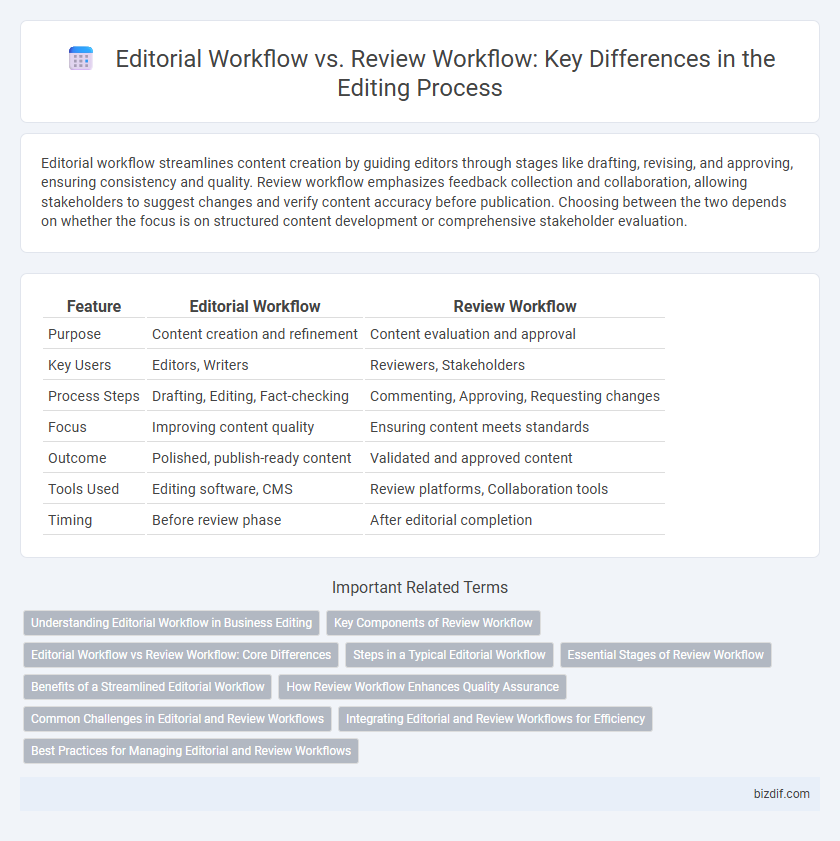Editorial workflow streamlines content creation by guiding editors through stages like drafting, revising, and approving, ensuring consistency and quality. Review workflow emphasizes feedback collection and collaboration, allowing stakeholders to suggest changes and verify content accuracy before publication. Choosing between the two depends on whether the focus is on structured content development or comprehensive stakeholder evaluation.
Table of Comparison
| Feature | Editorial Workflow | Review Workflow |
|---|---|---|
| Purpose | Content creation and refinement | Content evaluation and approval |
| Key Users | Editors, Writers | Reviewers, Stakeholders |
| Process Steps | Drafting, Editing, Fact-checking | Commenting, Approving, Requesting changes |
| Focus | Improving content quality | Ensuring content meets standards |
| Outcome | Polished, publish-ready content | Validated and approved content |
| Tools Used | Editing software, CMS | Review platforms, Collaboration tools |
| Timing | Before review phase | After editorial completion |
Understanding Editorial Workflow in Business Editing
Editorial workflow in business editing streamlines the process of content creation by defining clear stages such as drafting, revising, fact-checking, and final approval, ensuring accuracy and consistency. This structured approach improves collaboration among editors, writers, and stakeholders, reducing errors and accelerating publication timelines. Understanding the editorial workflow helps businesses maintain high-quality standards and enhances overall content management efficiency.
Key Components of Review Workflow
The key components of a review workflow include submission, reviewer assignment, feedback collection, and revision tracking, ensuring a structured process for content evaluation. Automated notification systems and version control play crucial roles in maintaining transparency and timely updates. Integrating collaboration tools enhances communication among editors, reviewers, and authors, optimizing the overall editorial quality.
Editorial Workflow vs Review Workflow: Core Differences
Editorial workflow centers on content creation, involving stages like drafting, editing, and final approval to ensure quality and consistency before publication. Review workflow primarily focuses on the evaluation process, emphasizing feedback, revisions, and validation from reviewers or stakeholders. Key differences include the editorial workflow's structured approach to content development versus the review workflow's iterative feedback loop for validation and refinement.
Steps in a Typical Editorial Workflow
A typical editorial workflow involves structured steps starting with content creation, followed by editing, fact-checking, and approval before publication. Each stage ensures quality control by assigning specific tasks to writers, editors, and proofreaders to optimize content accuracy and coherence. This sequence contrasts with a review workflow, which primarily focuses on feedback and revisions after initial content completion.
Essential Stages of Review Workflow
The review workflow in editing centers on three essential stages: content submission, collaborative evaluation, and final approval. During content submission, editors receive drafts for systematic examination, ensuring adherence to style and quality standards. Collaborative evaluation involves stakeholders providing structured feedback, facilitating iterative revisions before the manuscript moves to final approval for publication readiness.
Benefits of a Streamlined Editorial Workflow
A streamlined editorial workflow enhances content consistency, reduces errors, and accelerates publication timelines by clearly defining roles and responsibilities at each stage. It facilitates real-time collaboration among writers, editors, and reviewers, ensuring quicker feedback loops and seamless version control. Optimizing this process increases productivity and maintains high editorial standards, ultimately improving audience engagement and satisfaction.
How Review Workflow Enhances Quality Assurance
Review workflow enhances quality assurance by systematically involving multiple stakeholders in the evaluation process, ensuring thorough content accuracy and consistency. This iterative feedback loop helps identify errors, improve clarity, and align the final output with editorial standards. Editorial workflow primarily organizes content creation stages, while review workflow intensifies quality control through collaborative scrutiny.
Common Challenges in Editorial and Review Workflows
Editorial and review workflows commonly face challenges such as version control issues, miscommunication among team members, and delayed feedback cycles. Maintaining consistency across multiple document revisions and ensuring timely input from all stakeholders can hinder project timelines. Effective workflow management tools and clear communication protocols are essential to overcoming these obstacles.
Integrating Editorial and Review Workflows for Efficiency
Integrating editorial and review workflows streamlines content production by enabling simultaneous editing and feedback processes, reducing turnaround time and minimizing errors. Utilizing collaborative platforms with version control ensures real-time updates and transparent communication between editors and reviewers. This cohesive approach enhances workflow efficiency, resulting in higher-quality content delivered faster.
Best Practices for Managing Editorial and Review Workflows
Efficient management of editorial and review workflows requires clear delineation of roles and responsibilities between editors and reviewers to streamline content approval processes. Implementing standardized templates and milestone tracking ensures consistent quality control and timely feedback integration. Leveraging collaborative platforms with version control enhances transparency and reduces bottlenecks in both editorial revisions and review cycles.
Editorial Workflow vs Review Workflow Infographic

 bizdif.com
bizdif.com